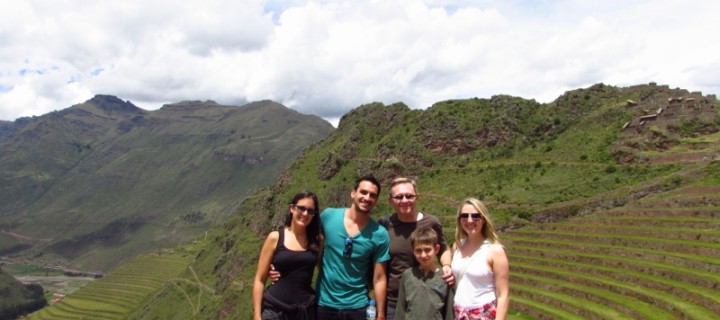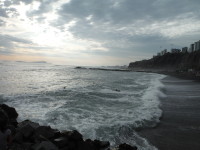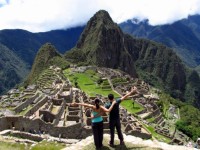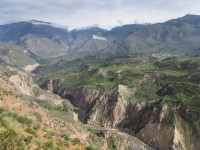After our Machu Picchu adventure, we are now in Pisac!
The past weeks have been quite intense in terms of traveling and moving, staying no more than 3-4 days in one place. You guys may perhaps laugh but it is tiring..! The upcoming trip’s planning, hotel booking, transportation, what to see/what to do, traveling and blogging became almost a full time job !
So this being said, we needed some time off to relax and enjoy the same place for a week. We have been more than happy to have chosen Pisac, a peaceful and quiet place, 40 mins away from Cusco. The great aspect of this village is also its variety of yoga classes, dance classes, medicinal treatments and much more! Pisac is in a way the new Ubud of Peru.
We settled down in Nidra Wasi, a cute Yoga bed & breakfast hotel that has been extremely welcoming. The owner, Daya, a friendly young guy from Lima, offered Ashtanga yoga and Kundalini classes everyday. The food was vegetarian and the space was right in the Sacred Valley surrounded by mountains and nature. It is small to say we were literally in paradise for 7 days 🙂 We really enjoyed practicing yoga again everyday. Our body surprisingly was not too tight after some time of not practicing.
As mentioned in our last article, we try to practice yoga as much as we can during our trip but sometimes the conditions (hotel, space, altitude!) are not the best environments. Nidra Wasi gave everything we needed and even more. During our time there, Daya has organized a workshop on yoga and dance. During that day, we not only learned some new yoga poses but also some steps in capoeira, edible plants presentation and free dance class. What a program and what fun we had! Our time there has been a breath of fresh air and relax time, meeting nice and inspiring people.
We also took time to visit the Sacred Valley. Being in the middle of it, that would be too bad to miss the sacred sites made by the Incas hundreds of years ago. The Sacred Valley involves different sacred sites between Calca and Lamay, Pisac and Ollantaytambo. The Sacred Valley of the Incas is also referred as being the heartland of the Inca Empire. Unfortunately, we haven’t had enough time to get to visit all the sites but learnt quite a lot about the history of the empire.
The Inca Empire was actually the largest empire in pre-columbian America. The administrative, political, and military center of the empire was located in Cusco. The Inca civilization started in the 13th century until 1572 when the Spanish conquered the territory and destroyed a lot of the Incas possessions and culture. The Spanish conquistadors were led by Francisco Pizarro that clearly saw that they had reached a wealthy land with great treasures.
The Inca people were originally a pastoral tribe in the Cusco area around the 12th century. The main language was the Quechua. Pachacuti was important leader of the Inca civilization and its expansion. During his reign, he had much of the Andes mountain under control in Peru and Ecuador. It is said that Pachacuti directed the construction of the Machu Picchu.
The Inca culture
The Inca civilization had a wide range of habits and culture. We could have spent hours discovering their way of living very often in balance with the nature.
Socially, every Inca was assigned a task to do in life connected to their age, gender and social position. For example, women older that 50 years old would work on the confection of clothes or would be a nurse and/or help pregnant women to give birth. The Incas were also incredible builders and architects. Their irrigation system, palaces, temples and fortifications can been seen all over the Andes. Their sophisticated farming system, known as the vertical archipelago model of agriculture is for example well admired. The Inca made also many discoveries in medicine and used to use a lot the Coca leaves seem to be sacred or magical.
In terms of religion, they believed in the nature like the sun, moon, water and animals as their gods. They also believed in reincarnation and used to do human sacrifices for the God and Goddess during important events.
Example of God and Goddess:
Apu Illapu – Rain God, prayed to when they need rain
Ayar Cachi – Hot-tempered God, causes earthquakes
Illapa – Goddess of lightning and thunder
Inti – sun god and patron deity of the holy city of Cusco
All this information came from our book and a very knowledge guide that we met through Vitaly and Elena, two of Juan’s friends from Florida. They are a sweet and friendly family doing a small road trip in Peru. Luckily, we could spend a day with them to hang out and see for real all the sacred Inca sites that are now protected. A big Thank you to Elena and Vitaly for giving us the opportunity to visit with them. We met them in Pisac and went with their guide all around the valley.
The Sacred Valley more in details
To start off, the valley was appreciated by the Incas due to its special geographical, high energy and climatic qualities. It was one of the empire’s main points for the extraction of natural wealth, and one of the most important areas in Peru for the corn production. Large scale of corn production started around 1400 expending urban agriculture in Moray and other places.
Let’s start the visit in Pisac
Pisac, as previously said, is a peaceful village situated at the Willkanuta river, at the end of the Sacred Valley. The village is known for its alternative therapies, yoga, local market on Sundays and its archaeological site.
The Inca ruins lie on top of a hill, over-viewing the village. The ruins are divided into groups that include baths, altars, water fountains, a ceremonial platform as well as a temple for the sun. As the Inca had the nature as their religion, it is therefore very common to find temples for the sun and the moon all over the archaeological sites. Different constructions have been made to define the changes of the seasons as well.
Pisac ruins are also known for the agricultural terraces lying on a steep hill. These terraces enabled people in the past to cultivate corn and potatoes. According to our guide, the techniques the Inca used to produce their corn and potatoes is still used nowadays.
Next stop Ollantaytambo
This small village is an archaeological site located 60 kilometers northwest of the city of Cusco, in the province of Urubamba.
When we first got there, Ollantaytambo charmed us for its beautiful plaza and cute shops, restaurants all around. It is a nice place where we could stop to have a coffee, talk to the locals or buy something from them.
The city is also the starting point for the Inca Trail or to catch the train to go the Machu Picchu. The traffic can be quite heavy at different points during the day.
During the Inca Empire, Ollantaytambo was the royal estate of Emperor Pachacuti as well as a ceremonial center. People on the way to the Machu Picchu used to stop in the village to take a rest or for religious purposes. Nowadays it is an important tourist attraction welcoming each year thousands of pilgrims and visitors.
The ruins of Sacsaywaman in Cusco and Moray are also important sites which we have unfortunately not visited.
Nevertheless, we had an amazing time spending a week in this beautiful valley and learn more about its complex history. Even if some facts of the history are unknown and mysterious, we could really feel the hard work made by the Incas and their intention to live in balance with the nature. In some way it is very sad the Spanish came and didn’t care to get the precious knowledge they could have transmit to us.
We left Pisac rested with full of energy to keep going north. We have some long bus rides ahead as we have to be out of Peru at the end of the month and we still have about 1500 km to go!! The next stop will be Lima for 4 days, then Mancora for 3 days and then Ecuador!
See you soon chicos!
Useful information:
Where to stay in Pisac: Nidra Wasi – Yoga Bed and Breakfast, 80 soles for the double room, with breakfast, 10mns on foot away from the center.
Where to eat: Intihuatana Lounge near the main plaza, local and vegetarian dishes and delicious fresh juices.
Where to have a good coffee: Blue Llama in the main plaza. Also only place where we can find an ATM machine.







































